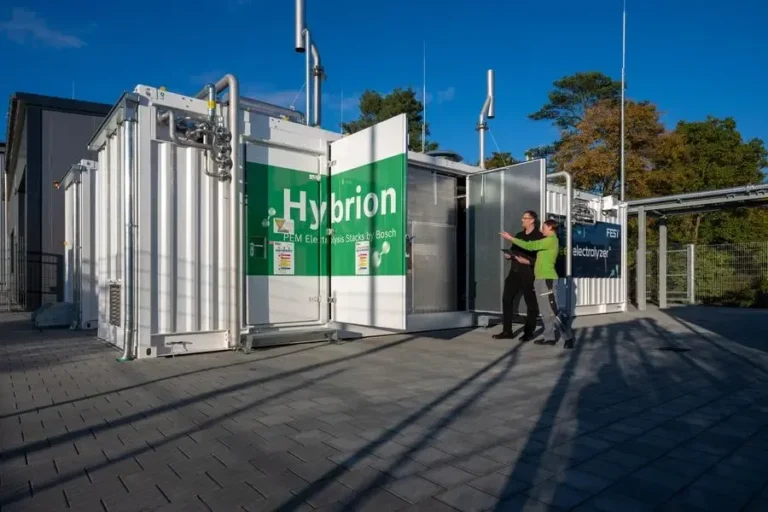Hydrogen is on the advance at Bosch: after officially launching Hybrion PEM electrolysis stacks (PEM = proton exchange membrane) in March, Bosch has now put two of them into operation in an electrolyzer at its Bamberg site. With a total output of 2.5 megawatts, it converts water into hydrogen and oxygen using renewable electricity – and meets the EU’s requirements for renewable hydrogen. At the same time, the commissioning of the electrolyzer in Bamberg marks the start of a new chapter: it is part of an entire hydrogen landscape built to demonstrate various ways of producing, storing, and using hydrogen. “Hydrogen plays a central role in a climate-neutral world, which is something we’re committed to achieving as a society in Germany and Europe, and it’s an ideal energy source. It can be produced, stored, and transported almost anywhere, and in a climate-neutral way. For Bosch, hydrogen continues to be a strategically important business,” says Dr. Markus Heyn, member of the Bosch board of management and chairman of the Mobility business sector. “The official start of operations for our electrolyzer and the opening of the hydrogen landscape here in Bamberg mark an important milestone for us.”
At the heart of the electrolyzer, which was built by FEST, a company based in Goslar, Germany, are two Bosch Hybrion electrolysis stacks manufactured in Bamberg. Each of these stacks has an output of 1.25 megawatts and produces around 23 kilograms of hydrogen per hour from water and electricity. At full load, the electrolyzer can produce more than 1 metric ton of hydrogen daily. That’s enough fuel for an electric 40-ton truck fitted with a Bosch fuel-cell power module (FCPM) to travel up to 14,000 kilometers.
The Bamberg hydrogen landscape features just such an FCPM, equipped with a Bosch fuel-cell stack, in continuous operation inside a “lifetime container” with a view to testing the module’s durability. The hydrogen to power the FCPM flows into the container from the electrolyzer via a pipeline network. Here, the hydrogen-producing process that previously ran in the PEM electrolysis stacks is now reversed: hydrogen and oxygen are fed into the FCPM’s fuel-cell stacks, where they react to produce water and electrical energy. The electricity generated by the FCPM flows back into the electrolyzer, where it is used both to test the electrolyzer and to produce hydrogen locally. These around-the-clock tests inside the lifetime container simulate a wide range of usage scenarios to ensure the durability and reliability of the FCPMs. Large-scale production of the FCPM started in Bosch’s Stuttgart-Feuerbach plant in mid-2023. It was recently nominated for the prestigious German President’s Future Prize. “Bosch can do hydrogen, and at scale,” says Thomas Pauer, the president of the Power Solutions division. “We got involved in the area at an early stage, made upfront investments, and are now offering market-ready technical solutions. That includes our fuel-cell power module. The fact that it was nominated for the German Future Prize proves that this Bosch technology is at the cutting edge. And that applies both to the fuel cells and to the electrolysis.”
Bamberg also has a second test station for the Hybrion PEM electrolysis stacks manufactured at the plant there. Before delivering stacks to customers, this is where Bosch ensures that they reliably achieve their performance and efficiency under real operating conditions. For example, various load profiles are simulated to test the reaction of each stack to electrical fluctuations. In addition, every Hybrion stack is activated before delivery so that it is immediately ready for use at the customer’s premises. Another feature of the hydrogen landscape is the 21-meter-high hydrogen tank, in which hydrogen from electrolysis can be stored at up to 50 bar.
Bosch has already reached its first milestones in electrolysis technology in 2025. Following the market launch in the spring, deliveries have begun to various customers and partners, including companies such as Kyros Hydrogen Solutions, Neumann & Esser, Pietro Fiorentini, and the latter’s subsidiary Hyter.
Breaking News:
- Nishka Momentous Jewellery Is All Set To Unveil Its 4th Showroom at Hamdan Street, Abu Dhabi.
- Emirates Park Zoo & Resort invites young explorers to an unforgettable Winter Camp adventure
- The event was held in celebration of International Volunteer Day. Mohammed Bin Rashid Library Participates in Expo of Volunteerism & Innovation
- Amna Al Shamsi becomes first Emirati appointed to IPSASB Consultative Advisory Group
- TOYOTA GAZOO Racing and Lexus Hold World Premiere of GR GT, GR GT3, and Lexus LFA Concept
- Essilor Luxottica Selected Holiday Gift Guide – For Him & Her
- Palo Alto Networks and IBM Plan to Launch Joint Solution to Accelerate Enterprise-Wide Quantum-Safe Readiness
- Ministry of Finance signs 3rd agreement under the ‘Retail Sukuk’ Initiative with Emirates Islamic Bank
Sunday, December 7

